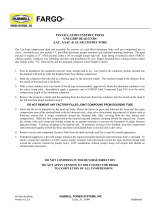Page is loading ...

FARGO
INS 879 (03/22/12) HUBBELL POWER SYSTEMS, INC.
Printed in U.S.A. Leeds, AL 35094 1908790000
INSTALLATION INSTRUCTIONS
CONVENTIONAL COMPRESSION DEADENDS
FOR AAC CONDUCTOR
The compression dead end assembly consists of an aluminum body with or without terminal pads and a steel eye dead
end forging. Assemblies may also include jumper terminals. If included, jumper terminals include mounting hardware.
The standard aluminum dead end terminal pad is angled at 15, as is the pad on the jumper terminal. This permits either a
30 or straight jumper loop take-off. Fittings are stamped with conductor type and diameter range, die size, minimum
press size, production date code and catalog number.
1. Prior to installation the conductor must be clean, straight and in lay. Any bend in conductor section will tend to make
the deadend body tube bow during compression.
2. Remove the protective plastic wrap. Set unwrapped connector on a clean surface and ensure the bores of the
aluminum deadend body is clear of foreign matter.
3. Coat the ribbed section of the steel deadend forging with Fargo joint compound type UJC and insert the coated
section into the aluminum deadend body. With the steel eye inserted until its felt washer is against the aluminum body
and aligned as needed relative to the insulator connection hardware, compress the aluminum body onto the steel eye
ribbed section using die tooling stamped on the aluminum body. Make first crimp next to knurl mark nearest the eye
end and continue crimping to the second knurl mark, overlapping crimps slightly to prevent formation of ribs between
crimps.
4. Inject Fargo joint compound into the mouth of the deadend body. For the approximate amount required, see table
below.
5. Mark the conductor end at insertion length. Insertion length is the distance from the from the third knurl ring to open
tube end.
6. With a clean stainless steel wire brush (V-brush type recommended), aggressively brush the conductor end over the
full circumference and insertion length. Immediately apply a generous coat of FARGO UJC over the just brushed
conductor strands. Insert conductor into the aluminum body to the insertion length. Rotate the aluminum body on the
conductor as needed to ensure full insertion.
7. Select AH die set specified on deadend body. Mount die halves in press and lubricate die faces and the conductor
crimp zone length of the deadend body with clean oil or clean plastic wrap. If plastic used as lubricant, ensure that it
wraps completely around the splice tube, fully covering both die face during each compression.
8. Move press to third knurl mark and make first on span side of that mark. Continue compressions out to the ends of
the deadend body. Overlap each crimp by an amount necessary to prevent the formation of ridges between adjacent
crimps. Be sure that full die closure occurs with each crimp. To minimize bowing of deadend tube during
compression, keep both die faces and splice crimp zone well lubricated during crimp operation, and keep the deadend
tube firmly seated in one die half while dies are closing.
9. Remove excess joint compound and any marking tape used. Remove die flash from deadend body and file or sand
for a smooth appearance.
10. If deadend supplied as a kit with jumper terminal, the required terminal hardware sheet is included. Refer to separate
instruction sheet for jumper terminal installation. EHV installations without jumper loops will require bolt shields on
terminal pad connections.
DO NOT COMPRESS IN THE REVERSE DIRECTION
DO NOT APPLY LINE TENSION TO DEADEND PRIOR TO COMPLETION OF ALL COMPRESSION
75AH 76AH 20AH 24AH 27AH 30AH 34AH 36AH 38AH 40AH 42AH 44AH 48AH
Deadend Body 12 / 15 0.05 0.08 0.15 0.24 0.34 0.50 0.56 0.62 0.82 0.90 1.10 1.20 1.32
FARGO type UJC-16 or HTJC-16 Joint Compound required (cartridges per fitting)
Die Size
Catalog
Series
Component
/






